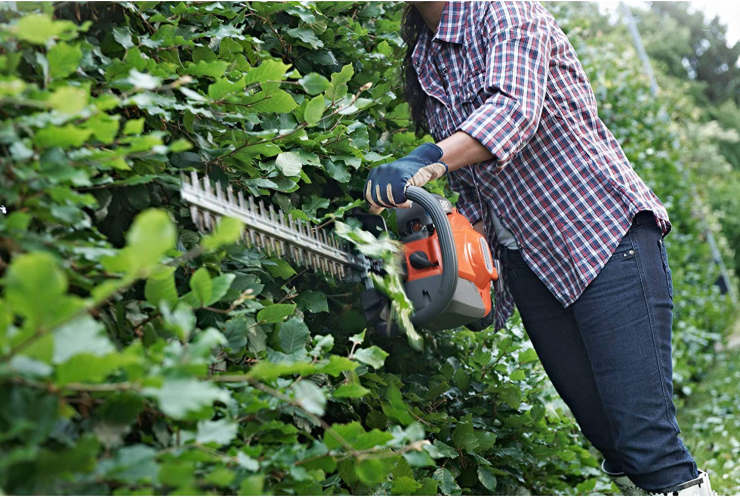Our Picks for Flowering Vines to Grow in North Carolina
Flowering vines make excellent ground covers, privacy screens, arbors, and more. Here are fifteen flowering vines that are native to North Carolina. Check them out to see which varieties are the best fit for your property!
Climbing Aster (Ampelaster carolinianus)
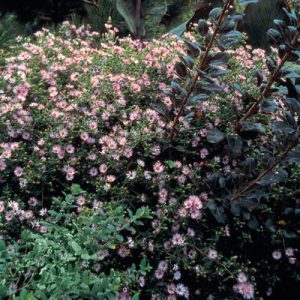
The climbing aster is a herbaceous perennial vine. It is native to the southeastern United States. This aggressive climber can be found throughout the wild of North Carolina and several of its neighboring states.
The climbing aster can grow as many as 12 feet in a single season. As it grows, it uses other plants and structures to support its weight. Climbing aster flowers between late summer and early fall. The blooms have seven to 20 narrow purple petals and yellowish-brown centers. Each flower measures 1 to 3 inches in diameter. These stunning plants tend to produce an abundance of flowers at once. With minimal guidance, the flowery thickets can easily be shaped into shade-giving arbors and decorative privacy screens.
Climbing aster should be planted alongside fence posts, porches, lattices, or sturdy plants. Elevated structures serve as the backbones of these fragile flowering vines. These sensitive growers should only be pruned in spring and summer. Winter pruning will stunt new growth and lead to a significant bud decrease.
Keep in mind that climbing aster remains evergreen in places with year-round warm weather. When planted in North Carolina’s chillier hardiness zones, climbing aster is likely to shed its leaves.
Cross Vine (Bigonia capreolata)
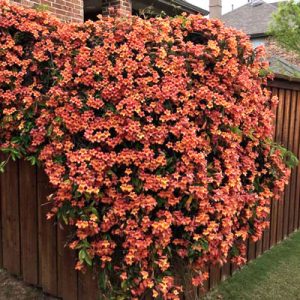
Cross vine is another woody perennial that is native to the southeastern United States. This impressive plant can climb 30 to 50 feet in a single year. Cross vine produces an abundance of trumpet-shaped, pink, orange, and yellow flowers. The blooms appear between late spring and summer. The flowers measure 1 to 2 inches in diameter. They grow in small clusters. These pollen-laden groupings make this a pollinator favorite. The plant’s foliage is dark green and pointed. The plant also sprouts clingy tendrils. These help it to cling to flat surfaces, such as wooden siding or stone walls.
While the cross vine’s flowers are incredibly stunning, they often go unappreciated. That is because they only grow from the tips of the plant.
American Groundnut (Apios Americana)
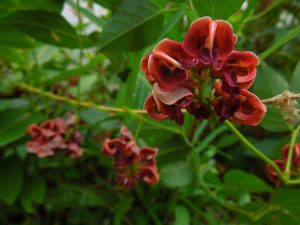
American groundnut, or potato bean, is a perennial vine that’s native to the wetlands of the Southeast. This plant produces small clusters of cone-shaped flowers. These stunning blooms boast painterly red and white features. The blossoms show between July and September. The vines can grow to be anywhere from 8 to 16 feet long. The roots spread horizontally.
This incredible flowering vine is a member of the legume family. Its potato-like tuber roots, young shoots, and burgundy seed pods are all safe for consumption. If you’re planting American groundnut in your garden, you’ll want to provide it with an object or plant that it can climb. Tall stalky plants are an excellent option. Keep in mind that the plant thrives in shady, moist conditions. It prefers sandy or gravelly soil. Prune it regularly to prevent it from spreading. Or else, propagate it in containers.
The plant’s flowers spring onto pollinators that are curious enough to seek its nectar. The plant’s most noted visitors are native bees. Of course, the plant’s many edible parts serve as food for humans and other animals.
Trumpet Vine (Campsis radicans)
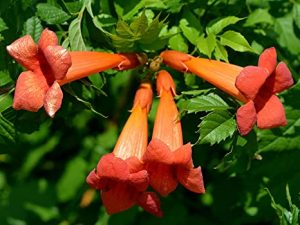
Trumpet vine, or trumpet creeper, is a fast-growing perennial vine that grows naturally throughout much of North Carolina. This incredible plant can grow to be 40 feet long in a single season. It produces an abundance of orange and yellow trumpet-shaped blooms. These tropical-looking flowers grow in small clusters. They serve as the perfect contrast to this plant’s thick, verdant foliage.
Trim your trumpet vine to prevent it from taking over your entire garden. Propagate your trumpet vine in a container if you’re concerned that it is going to take over your yard. Trumpet vine is not picky about conditions. It does well in both full sun and shade. Moreover, it can tolerate a wide variety of soil types.
There’s no need to water or fertilize the trumpet vine. In some ways, this flowering vine is the perfect plant specimen for lazy gardeners. Just don’t let this fast-growing plant species choke out other plants in your garden. Keep an eye out for hummingbirds, bees, and butterflies. Pollinators find it easy to travel between the trumpet vine’s nectar-rich flower clusters.
Swamp Leather Flower (Clematis crispa)
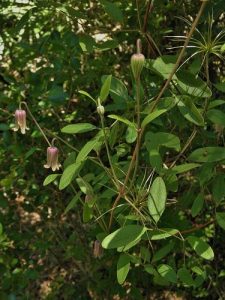
Swamp leather flower is a herbaceous vine that’s native to the southeastern United States. It can be found growing wild in the wetlands of North Carolina. It’s a member of the beloved buttercup family.
This slow-climbing perennial is sometimes referred to as curly clematis or blue-jasmine curlflower. This is because its urn-shaped flowers have distinctly curled ends. The purple, pink, and white flowers boast sepals rather than petals. They grow from the ends of the plant’s leafless stems. The droopy flowers typically bloom between March and September.
Plant swamp leather flowers along fences, arbors, trellises, etc. These long-blooming vines attract nectar-loving insets and seed-eating birds. They produce a lovely yet subtle fragrance. Swamp leather flowers can grow to be 10 feet high.
The vines can be propagated from root and wood cuttings or seeds. The plant does best in moist, acidic soil. It can tolerate direct sun and partial shade. The vine should be watered occasionally. However, soil amendments and nutrients are rarely needed.
Atlantic Pigeon Wings (Clitroia mariana)
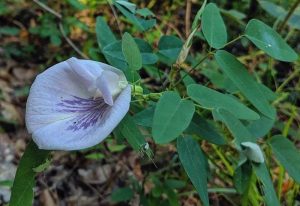
Atlantic pigeon wings, or butterfly pea, is a perennial vine that produces pinkish-purple flowers. The wing-like petals of this plant surround a pea-like protrusion. The flower’s unique form makes it a favorite of flower enthusiasts. This relatively short vine is capable of growing 3 to 4 feet in length and 2 to 3 feet in width in a single season. It thrives when it is established in full sun and sandy, dry soil.
Butterfly pea flowers in early summer. When it does, it all sorts of birds and small animals. Atlanta pigeon wings should be propagated from seed. It thrives in all of North Carolina’s hardiness zones and requires little to no ongoing maintenance.
Virgin’s Bower (Clematis virginiana)
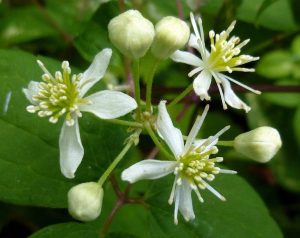
Virgin’s bower is a hardy vine that’s closely related to triple clematis. This fast-growing specimen produces clusters of star-shaped, white flowers alongside dense bunches of green foliage. These stunning blossoms produce a rich fragrance.
Virgin’s bower is native to the eastern United States. This hardy perennial can be found everywhere from forests to valleys throughout North Carolina. It’s a natural climber with the ability to grow 20 feet in a single season. When propagating your virgin’s bower, look for a spot with partial shade and moist soil. Keep in mind that this plant spreads easily. Prune it regularly to ensure that it says within your targeted growing area.
We love that this plant resists things like deer and disease. It needs very little training to take over walls, porches, and fences. It’s also a favorite of native pollinators. However, the entire plant is poisonous to mammals, including dogs, horses, and other common pets.
Dutchman’s Pipe (Aristolochia macrophylla)
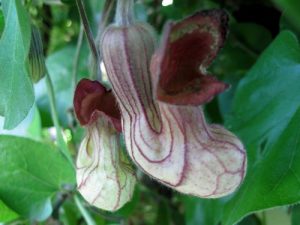
Dutchman’s pipe is a woody vine that produces pipe-shaped flowers. The vibrant pink blossoms grow in clusters at the ends of the plant’s stems. These impressive blooms are complimented by large clusters of heart-shaped leaves. While this vine is incredibly attractive, it also produces a very pungent odor. Some say the plant smells like rotting meat.
Dutchman’s pipe can grow up to 25 feet in a season. Since the plant’s flowers are rather smelly, we don’t recommend that you propagate it close to entryways, porches, or doors. The vines should be grown from seed or cuttings. It thrives in moist, well-draining soil and direct sun.
Climbing Hempvine (Mikania scandens)
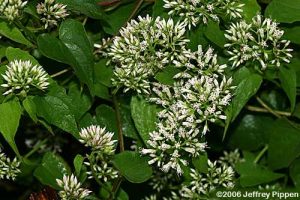
Climbing hempvine is a twining vine that produces clusters of whitish-pink flowers and heart-shaped leaves. It grows naturally throughout North Carolina and other parts of the Southeast. Its preferred habits are forests and wetlands.
This fast-growing climber produces an abundance of green leaves and white flowers. It typically stays in bloom from June to August. It should be planted in wet, shaded areas. Its prominent flowers are welcome additions to most gardens and landscapes.
This plant is often used in folk medicine. In fact, it produces more vitamin C than most citrus fruits. The flowers can be eaten directly off the plant.
Wild Passion Flower (Passiflora incarnata)
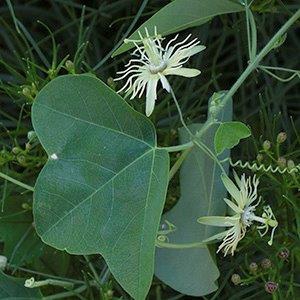
This stunning vine grows wild in parts of the southeastern United States. Wild passion flower, or maypop, produces a mesmerizing array of flowers. The blooms are made up of dozens of wispy purple tepals. The blossoms show from midsummer to early fall. They’re accompanied by dark green leaves. In the fall, the plant produces edible fruits called maypops.
These incredible vines can grow up to 8 feet in a season. The vines are not easily trained. We recommend that you plant this vine next to something that you’d like it to climb up. It attaches itself to structures via curled tendrils. These curly protrusions are similar to those found on grape vines. The plant’s incredible display of flowers makes it a lovely addition to any garden or landscape.
American Wisteria (Wisteria fritescens)
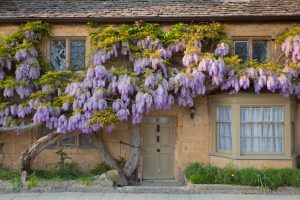
This high-reaching deciduous vine produces grape-like tendrils of purple flowers and clusters of green foliage. This plant grows naturally throughout the American Southeast. However, it is often confused for invasive Japanese wisteria. American wisteria is less aggressive. It’s also better received by native pollinators.
American wisteria can grow to be 25 to 30 feet tall. It’s often trained to grow up arbors and columns.
Carolina Yellow Jasmine (Gelsemium sempervirens)

This cheerful flowering vine is native to North Carolina. Carolina jasmine, or Carolina yellow jasmine, can grow to be anywhere from 12 to 20 feet in length. The woody perennial can be trained in just a few seasons. It produces an impressive array of funnel-shaped yellow flowers. The flowers’ fragrance, shape, and color make them attractive to a wide range of pollinators, including hummingbirds and butterflies.
Carolina yellow jasmine is an evergreen that blooms well into fall. It was shiny green leaves and capsule-shaped fruits. It handles pests and diseases well.
If left to grow freely, Carolina jasmine will become a dense groundcover. When tied up or guided, the vine will extend vertically.
Wild Potato Vine (Ipomoea pandurata)
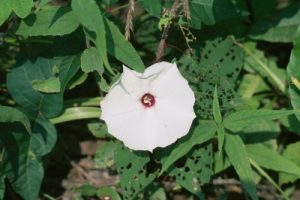
Wild potato vine is a herbaceous perennial vine that is native to North America. This gorgeous specimen has heart-shaped leaves and medium-length stems. It produces an abundance of funnel-shaped flowers that boast predominantly white petals and deep purple centers. These impressive vines can grow to be anywhere from 15 to 30 feet tall and 3 to 6 feet wide.
The wild potato vine is a member of the morning glory family. As such, the flowers typically only open in the morning. These early bloomers do best when they are planet alongside porches, fences, arbors, trellises, and walls. Keep in mind that they prefer well-draining soil and mild shade. Keep in mind that wild potato vine is toxic to some animals. Wild potato vine plants are also incredibly resistant to pests and diseases.
We hope you enjoyed our rundown of the top flowering vines for North Carolina gardens! What varieties are you eyeing and how will you train them?


